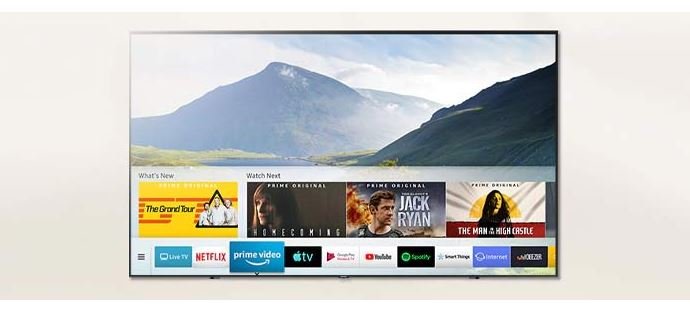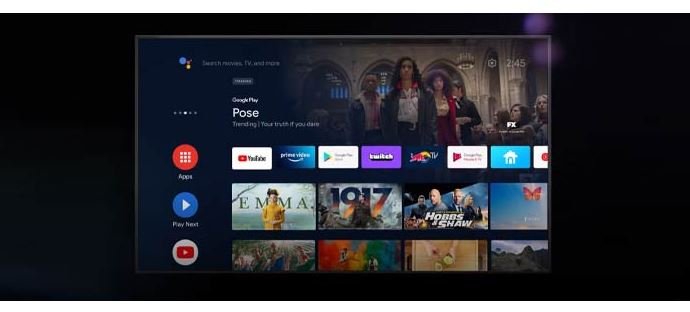When choosing a smart TV, there are many parameters to consider; visual quality, prevalent use, design, and also the operating system. The most popular OS are Tizen OS, WebOS, Android TV, etc … let’s see them in detail:
WebOS (currently used on LG TVs)
The history of WebOS is very long. Contrary to popular belief, the original Linux kernel-based system was developed by a company called Palm, later sold to Hewlett-Packard and eventually to LG Electronics. The first device to use it was a PDA in 2009. Although it’s LG’s operating system, as we know, it was used on a TV for the first time in 2014. Since its introduction, it has immediately proved to be an absolute protagonist. The user interface is intuitive and non-invasive. The main menu still develops along the bottom of the screen, divided between Apps, connected accessories, and settings.
Its evolution over the years has been continuous. For example, support for Alexa, Google Assistant, Apple HomeKit 2, and many functions for home automation. There are also new apps such as Apple TV, Disney +, and many others.
Overall, the interface is fluid and fast. The “how much” clearly depends on the processor model the TV is equipped with. In general, there is great attention in this aspect, even in economic models.
The latest functions introduced in the version on the market include:
- Two-tier choice revamped Launcher Bar
- Quick settings menu now customizable
- Sports Alert feature that alerts you before, during, and after a sporting event you are subscribed to
- AI functionality that optimizes image quality based on content characteristics leverages the analysis carried out by artificial intelligence based on deep learning.
- AI brightness control that, when active, sets the screen brightness based on the brightness detected around the TV
- Art gallery mode that turns the TV into a painting
- AI sound/AI Sound Pro that, when active, ensures sound effects and simulated surround based on artificial intelligence depending on the content.
Tizen OS (common in Samsung Smart TVs)
This is Samsung’s proprietary system. It is also based on Linux. The original project, born in 2011, started from a platform for Html5 applications intended for mobile devices. The evolution of the market has brought it into smartphones and smartwatches. Since 2015, it has been heavily modified with strong inspiration to WebOS and landed in televisions, where thanks to the sales of Samsung TVs, it has also become the most popular smart-TV system in the world.
Its strength over the years has been the ease of use, functionality, and the App store available. In fact (apart from the WebOS pointing system), there is no function that is not present also on this system, with the current positive note that Tizen allows you to have the multiview to view 2 sources at the same time.
The Samsung app store is large and easy to navigate, in the number of Apps it plays like webOS. Tizen is equipped with Samsung’s proprietary Bixby voice assistant, which can also integrate with smart home devices from the same manufacturer and/or compatible. It also supports Alexa.
Android TV
This OS derives from its smartphone counterpart. It is called Android TV and is used by several manufacturers, including Sony and Philips. The future of Panasonic remains uncertain and today uses My Home Screen. It has recently marketed a few models with Android, and the switch may be imminent.
Among the 3 most popular OS, Android TV is the one that offers greater customization. Access to the google store also allows you to find the largest number of Apps in the lot, even if they are not exactly treated in detail, such as those of WebOS.
The platform is slightly less intuitive than the competition, but there will be no problems after a few days of use. It also tends not to rely on a bar at the bottom of the screen but prefers to always show the user a full-screen screen.
As for voice control, Android TV relies on Google Assistant, but it also supports Alexa.
Saphi OS
This system is also based on a Linux kernel. In Europe, it is currently used on some Philips TV models. It was born from the need to keep the price of the TV low. It was therefore born to work on modest processors and with a limited amount of RAM. This smart TV operating system offers a simplified interface with discrete fluidity (depending on the processor) but rarely uses accessory functions. For example, it completely cuts background processing and system animations.
The availability of the App is obviously not at the level of Android TV (or Tizen and WebOS). There is no shortage of classics such as Netflix, Rakuten TV, YouTube, and Amazon Prime Video, all in 4K, and all with HDR support. With some slight uncertainty, it is also possible to see Rai Play and Mediaset Play, while, for example, Apple TV and Disney + are absent.
The voice assistant it relies on is Alexa. In general, the remote controls provided by Philips always have a built-in microphone.
Vidaa OS
This is another smart TV operating system generally used for rather cheap TVs, although not always. You can find it on Hisense TVs such as U71Q.
Its interface looks more or less like all the others. The animations have been reduced to a minimum. The opening times of the App are certainly not the fastest, but in the end, it is still functional.
The most famous apps such as Netflix, Prime Video, Rakuten, Youtube, Chili, and TimVision are present. In its VIDAA U4.0 version of 2020, Rai Play and Mediaset Play were added, while Disney + and Apple TV were absent.
As far as the system supports the Alexa voice assistant, the remote is also equipped with a built-in microphone in many Hisense models.
What is the best Smart TV Operating System?
Concluding, we can see that the 3 main systems, Tizen, WebOS, Android TV, now behave almost identical. All three have the same functions. Therefore, it becomes a more personal choice than anything else.
The important thing is that they guarantee adequate support for years to come if new streaming services emerge. In fact, as it was for Disney + or DAZN, there is no doubt that the appropriate Apps will also be released on TVs marketed for 3 or 4 years.
Having to find differences between the 3 OS versions currently in use, they can be listed in this comparative table below:
|
System |
WebOS |
Tizen |
Android TV |
|
Ease of Use |
10 | 9 | 8 |
|
Speed |
9 | 8 | 7 |
|
Number of Apps |
8 | 8 | 10 |
|
Quality of Apps |
9 | 9 | 8 |
|
Update Support |
8 | 8 | 7 |
|
Functions |
9 | 8 | 9 |
|
Search Function |
7 | 9 | 9 |
|
Gallery Mode |
8 | 10 | 8 |
|
Multiview |
No | Yes | Yes |
|
Remote Control With Pointing |
Yes | No | No |
The other operating systems, SaphiOS and Vidaa OS, are clearly of a lower level. They will certainly be subject to shortcomings. Fortunately, for the most part, they are used on very cheap products.



